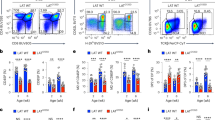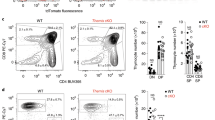Abstract
Antigen recognition by T cell antigen receptors (TCRs) is thought to 'unmask' a proline-rich sequence (PRS) present in the CD3ε cytosolic segment, which allows it to trigger T cell activation. Using 'knock-in' mice with deletion of the PRS, we demonstrate here that elimination of the CD3ε PRS had no effect on mature T cell responsiveness. In contrast, in preselection CD4+CD8+ thymocytes, the CD3ε PRS acted together with the adaptor protein SLAP to promote CD3ζ degradation, thereby contributing to downregulation of TCR expression on the cell surface. In addition, analysis of CD4+CD8+ thymocytes of TCR-transgenic mice showed that the CD3ε PRS enhanced TCR sensitivity to weak ligands. Our results identify previously unknown functions for the evolutionarily conserved CD3ε PRS at the CD4+CD8+ developmental stage and suggest a rather limited function in mature T cells.
This is a preview of subscription content, access via your institution
Access options
Subscribe to this journal
Receive 12 print issues and online access
$209.00 per year
only $17.42 per issue
Buy this article
- Purchase on Springer Link
- Instant access to full article PDF
Prices may be subject to local taxes which are calculated during checkout








Similar content being viewed by others
References
Hogquist, K.A., Baldwin, T.A. & Jameson, S.C. Central tolerance: learning self-control in the thymus. Nat. Rev. Immunol. 5, 772–782 (2005).
Ericsson, P.O. & Teh, H.S. The protein tyrosine kinase p56lck regulates TCR expression and T cell selection. Int. Immunol. 7, 617–624 (1995).
Sosinowski, T., Killeen, N. & Weiss, A. The Src-like adaptor protein downregulates the T cell receptor on CD4+CD8+ thymocytes and regulates positive selection. Immunity 15, 457–466 (2001).
Bonifacino, J.S. et al. Novel post-translational regulation of TCR expression in CD4+CD8+ thymocytes influenced by CD4. Nature 344, 247–251 (1990).
Nakayama, T. et al. Inhibition of T cell receptor expression and function in immature CD4+CD8+ cells by CD4. Science 249, 1558–1561 (1990).
Wiest, D.L. et al. Regulation of T cell receptor expression in immature CD4+CD8+ thymocytes by p56lck tyrosine kinase: basis for differential signaling by CD4 and CD8 in immature thymocytes expressing both coreceptor molecules. J. Exp. Med. 178, 1701–1712 (1993).
Cosgrove, D. et al. Mice lacking MHC class II molecules. Cell 66, 1051–1066 (1991).
Molina, T.J. et al. Profound block in thymocyte development in mice lacking p56lck. Nature 357, 161–164 (1992).
McCarthy, S.A., Kruisbeek, A.M., Uppenkamp, I.K., Sharrow, S.O. & Singer, A. Engagement of the CD4 molecule influences cell surface expression of the T-cell receptor on thymocytes. Nature 336, 76–79 (1988).
Kearse, K.P. et al. Developmental regulation of αβ T cell antigen receptor expression results from differential stability of nascent TCRα proteins within the endoplasmic reticulum of immature and mature T cells. EMBO J. 13, 4504–4514 (1994).
Riberdy, J.M., Mostaghel, E. & Doyle, C. Disruption of the CD4-major histocompatibility complex class II interaction blocks the development of CD4+ T cells in vivo. Proc. Natl. Acad. Sci. USA 95, 4493–4498 (1998).
Myers, M.D., Dragone, L.L. & Weiss, A. Src-like adaptor protein down-regulates T cell receptor (TCR)-CD3 expression by targeting TCRζ for degradation. J. Cell Biol. 170, 285–294 (2005).
Myers, M.D. et al. Src-like adaptor protein regulates TCR expression on thymocytes by linking the ubiquitin ligase c-Cbl to the TCR complex. Nat. Immunol. 7, 57–66 (2006).
Sosinowski, T., Pandey, A., Dixit, V.M. & Weiss, A. Src-like adaptor protein (SLAP) is a negative regulator of T cell receptor signaling. J. Exp. Med. 191, 463–474 (2000).
Naramura, M., Kole, H.K., Hu, R.J. & Gu, H. Altered thymic positive selection and intracellular signals in Cbl-deficient mice. Proc. Natl. Acad. Sci. USA 95, 15547–15552 (1998).
Roehm, N. et al. The major histocompatibility complex-restricted antigen receptor on T cells: distribution on thymus and peripheral T cells. Cell 38, 577–584 (1984).
Lucas, B., Stefanova, I., Yasutomo, K., Dautigny, N. & Germain, R.N. Divergent changes in the sensitivity of maturing T cells to structurally related ligands underlies formation of a useful T cell repertoire. Immunity 10, 367–376 (1999).
Davey, G.M. et al. Preselection thymocytes are more sensitive to T cell receptor stimulation than mature T cells. J. Exp. Med. 188, 1867–1874 (1998).
Eck, S.C. et al. Developmental alterations in thymocyte sensitivity are actively regulated by MHC class II expression in the thymic medulla. J. Immunol. 176, 2229–2237 (2006).
Li, Q.J. et al. miR-181a is an intrinsic modulator of T cell sensitivity and selection. Cell 129, 147–161 (2007).
Alarcon, B., Gil, D., Delgado, P. & Schamel, W.W. Initiation of TCR signaling: regulation within CD3 dimers. Immunol. Rev. 191, 38–46 (2003).
Schamel, W.W., Risueno, R.M., Minguet, S., Ortiz, A.R. & Alarcon, B. A conformation- and avidity-based proofreading mechanism for the TCR-CD3 complex. Trends Immunol. 27, 176–182 (2006).
Gil, D., Schamel, W.W., Montoya, M., Sanchez-Madrid, F. & Alarcon, B. Recruitment of Nck by CD3ε reveals a ligand-induced conformational change essential for T cell receptor signaling and synapse formation. Cell 109, 901–912 (2002).
Szymczak, A.L. et al. The CD3ε proline-rich sequence, and its interaction with Nck, is not required for T cell development and function. J. Immunol. 175, 270–275 (2005).
Kesti, T. et al. Reciprocal regulation of SH3 and SH2 domain binding via tyrosine phosphorylation of a common site in CD3ε. J. Immunol. 179, 878–885 (2007).
Risueno, R.M., Gil, D., Fernandez, E., Sanchez-Madrid, F. & Alarcon, B. Ligand-induced conformational change in the T-cell receptor associated with productive immune synapses. Blood 106, 601–608 (2005).
Risueno, R.M., van Santen, H.M. & Alarcon, B. A conformational change senses the strength of T cell receptor-ligand interaction during thymic selection. Proc. Natl. Acad. Sci. USA 103, 9625–9630 (2006).
Merkenschlager, M. et al. How many thymocytes audition for selection? J. Exp. Med. 186, 1149–1158 (1997).
Watanabe, Y. et al. A murine thymic stromal cell line which may support the differentiation of CD4−8− thymocytes into CD4+8− αβ T cell receptor positive T cells. Cell. Immunol. 142, 385–397 (1992).
Kisielow, P., Bluthmann, H., Staerz, U.D., Steinmetz, M. & von Boehmer, H. Tolerance in T-cell-receptor transgenic mice involves deletion of nonmature CD4+8+ thymocytes. Nature 333, 742–746 (1988).
Lantz, O., Grandjean, I., Matzinger, P. & Di Santo, J.P. Gamma chain required for naive CD4+ T cell survival but not for antigen proliferation. Nat. Immunol. 1, 54–58 (2000).
Takahama, Y., Shores, E.W. & Singer, A. Negative selection of precursor thymocytes before their differentiation into CD4+CD8+ cells. Science 258, 653–656 (1992).
Azzam, H.S. et al. CD5 expression is developmentally regulated by T cell receptor (TCR) signals and TCR avidity. J. Exp. Med. 188, 2301–2311 (1998).
Gil, D., Schrum, A.G., Alarcon, B. & Palmer, E. T cell receptor engagement by peptide-MHC ligands induces a conformational change in the CD3 complex of thymocytes. J. Exp. Med. 201, 517–522 (2005).
Minguet, S., Swamy, M., Alarcon, B., Luescher, I.F. & Schamel, W.W. Full activation of the T cell receptor requires both clustering and conformational changes at CD3. Immunity 26, 43–54 (2007).
Malissen, M. et al. T cell development in mice lacking the CD3-ζ/η gene. EMBO J. 12, 4347–4355 (1993).
Malissen, B. An evolutionary and structural perspective on T cell antigen receptor function. Immunol. Rev. 191, 7–27 (2003).
van Oers, N.S., Killeen, N. & Weiss, A. Lck regulates the tyrosine phosphorylation of the T cell receptor subunits and ZAP-70 in murine thymocytes. J. Exp. Med. 183, 1053–1062 (1996).
Bladt, F. et al. The murine Nck SH2/SH3 adaptors are important for the development of mesoderm-derived embryonic structures and for regulating the cellular actin network. Mol. Cell. Biol. 23, 4586–4597 (2003).
Norment, A.M., Forbush, K.A., Nguyen, N., Malissen, M. & Perlmutter, R.M. Replacement of pre-T cell receptor signaling functions by the CD4 coreceptor. J. Exp. Med. 185, 121–130 (1997).
Dave, V.P., Allman, D., Wiest, D.L. & Kappes, D.J. Limiting TCR expression leads to quantitative but not qualitative changes in thymic selection. J. Immunol. 162, 5764–5774 (1999).
Malissen, M. et al. Regulation of TCR α and β gene allelic exclusion during T-cell development. Immunol. Today 13, 315–322 (1992).
Davodeau, F. et al. The tight interallelic positional coincidence that distinguishes T-cell receptor Jα usage does not result from homologous chromosomal pairing during VαJα rearrangement. EMBO J. 20, 4717–4729 (2001).
Kadlecek, T.A. et al. Differential requirements for ZAP-70 in TCR signaling and T cell development. J. Immunol. 161, 4688–4694 (1998).
Martin, B., Becourt, C., Bienvenu, B. & Lucas, B. Self-recognition is crucial for maintaining the peripheral CD4+ T-cell pool in a nonlymphopenic environment. Blood 108, 270–277 (2006).
Malissen, M. et al. Altered T cell development in mice with a targeted mutation of the CD3-ε gene. EMBO J. 14, 4641–4653 (1995).
Laurent, J., Bosco, N., Marche, P.N. & Ceredig, R. New insights into the proliferation and differentiation of early mouse thymocytes. Int. Immunol. 16, 1069–1080 (2004).
Wang, Y. et al. Single and combined deletions of the NTAL/LAB and LAT adaptors minimally affect B-cell development and function. Mol. Cell. Biol. 25, 4455–4465 (2005).
Acknowledgements
We thank H. Boukarabila, C. Boyer, Y. Wang, S. Yamasaki, A. Tafuri, I. Prinz, H.T. He and L. Poulin for discussions; P. Grenot, M. Barad, N. Brun, M. Richelme, P. Perrin, F. Danjan and A. Gillet for advice and technical assistance; D. Gil (Mayo Clinic Rochester) for GST and GST–Nck-SH3.1 constructs; S. Yamasaki (Riken Research Center for Allergy and Immunology) for Tst4-DL1 cells; and A.M. Schmitt-Verhulst (Centre d'Immunologie de Marseille-Luminy) for biotin-conjugated anti-H-2Kb. Supported by the Centre National de la Recherche Scientifique, Institut National de la Santé et de la Recherche Médicale, European Communities (MUGEN Network of Excellence), Agence Nationale pour la Recherche (Plate-forme Technologique du Vivant IBISA-MNG), Association pour la Recherche sur le Cancer, Fondation pour la Recherche Médicale, Ecole Normale Supérieure (M.Mi.) and European Molecular Biology Organization (R.R.).
Author information
Authors and Affiliations
Contributions
All authors contributed to discussions of experimental design and data analysis; M.Mi. did all experimental studies unless otherwise indicated; A.S. provided technical assistance; C.G. and R.R. helped with biochemistry and calcium imaging; E.A. helped with the 'knock-in' strategy; A.W. provided suggestions and mice deficient in SLAP and Zap70; M.Ma. and B.M. directed the study; and M.Mi. and B.M. wrote the manuscript.
Corresponding author
Supplementary information
Supplementary Text and Figures
Supplementary Methods, Supplementary Figures 1–13 and Supplementary Tables 1–2 (PDF 3755 kb)
Rights and permissions
About this article
Cite this article
Mingueneau, M., Sansoni, A., Grégoire, C. et al. The proline-rich sequence of CD3ε controls T cell antigen receptor expression on and signaling potency in preselection CD4+CD8+ thymocytes. Nat Immunol 9, 522–532 (2008). https://doi.org/10.1038/ni.1608
Received:
Accepted:
Published:
Issue Date:
DOI: https://doi.org/10.1038/ni.1608
This article is cited by
-
Lipid-dependent conformational dynamics underlie the functional versatility of T-cell receptor
Cell Research (2017)
-
A novel pathogenic frameshift variant of CD3E gene in two T-B+ NK+ SCID patients from Turkey
Immunogenetics (2017)
-
T cell specific adaptor protein (TSAd) promotes interaction of Nck with Lck and SLP-76 in T cells
Cell Communication and Signaling (2015)
-
Insights into the initiation of TCR signaling
Nature Immunology (2014)
-
Quantitative proteomics analysis of signalosome dynamics in primary T cells identifies the surface receptor CD6 as a Lat adaptor–independent TCR signaling hub
Nature Immunology (2014)



